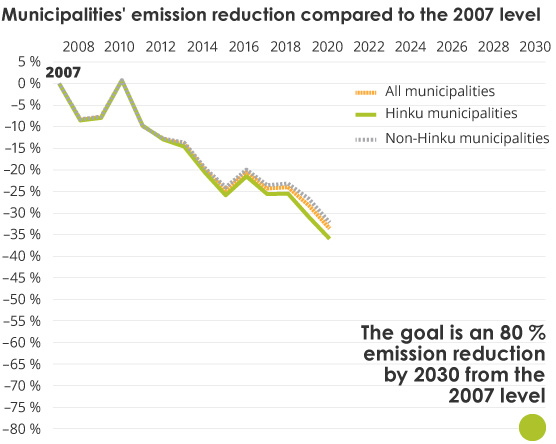Many of the municipalities in Finland have set emission reduction targets for themselves. (Mattinen-Yuryev et al., 2021). For example, the Towards Carbon Neutral Municipalities (Hinku) network’s municipalities are aiming to reduce emissions by 80% between 2007 and 2030.
The work of the Hinku network began as a small project of five municipalities in 2008. Currently, there are 80 Hinku municipalities, in addition to which there are five regions in the network. Upon becoming a Hinku municipality, the municipality commits to take into account the climate perspective in all its significant decision-making. In addition, the municipality must, among other things, join the municipal energy efficiency agreement and draw up a plan for reducing greenhouse gas emissions.
The Finnish Environment Institute coordinates the network of Hinku municipalities. Although the network provides expert and peer support for climate work, the overall commitment to emission reduction targets and the promotion of practical measures may be incomplete (Riekkinen et al. 2020). The most significant obstacle to the climate work of municipalities is often the lack of both time and money.
Acknowledging the resource challenges faced by municipalities, what is the benefit of joining the network? Can improvements in the efficiency of the Hinku network’s municipalities’ climate work be observed in emission trends?
Will joining Hinku make emission reductions more effective?
Suitable indicators are needed for monitoring the climate work of municipalities. In order to enable monitoring, the Finnish Environment Institute publishes annual municipal emissions data as an open service. The model developed for the calculation of emissions, the ALas system, uses the emissions according to the so-called Hinku calculation rules as the default method of calculation, which are considered to be directly or indirectly influenced by the municipality (Lounasheimo et al., 2020).
Between 2007 and 2020, the development of emissions has been relatively similar for all municipalities until 2012. After this, the emission paths differ so that the combined emissions of the municipalities belonging to Hinku have been lower than those of the municipalities not belonging to the Hinku network.
On the basis of these results, however, no direct conclusions can be drawn about the connection between joining Hinku and emissions trends – some municipalities have only joined Hinku in recent years. On the other hand, already climate-aware municipalities may have been selected as municipalities of the Hinku network.
In order to draw slightly more far-reaching conclusions from the connection of Hinku to the emissions trends in a municipality, this connection has been studied using statistical tools (Karhinen et al. 2021). Other changes in the municipality not related to climate work, such as the population, the party composition of the municipal council, fuel prices and other factors, were separated from the effects of joining Hinku.
Statistical modelling showed that in 2005–2018 the emissions of Hinku municipalities have been on average 3% lower in the period than they would have been if they had not joined Hinku. Climate work had thus become more efficient thanks to the network.

Emissions trends of all municipalities and municipalities belonging to and not belonging to the Hinku network in 2007–2020. The goal is an 80 % emission reduction by 2030 from the 2007 level. © SYKE
Hinku membership brings support, visibility and weight to climate work
What, then, could be the reason for this difference? The survey, which included representatives from forty Hinku municipalities, asked, among other things, what practical effects the municipalities have experienced from joining the network. More than half of the interviewees felt that joining the Hinku network has promoted emission reductions through concrete measures (Riekkinen et al. 2020). According to the representatives of the Hinku municipalities interviewed in 2019, the most important actions have included measures related to energy production, energy efficiency in buildings, transport and the increase of solar power. The interviewees felt that the network had provided motivation, inspiration and peer support (Riekkinen et al. 2020). Hinku membership has also provided valuable expert support, as well as communication support and media visibility.

Concrete climate action has also been promoted in municipal organisations by the fact that the required measures can be justified to decision-makers through Hinku membership. In Hinku municipalities, general climate work challenges are being tackled, but despite them, municipalities have managed to find solutions through, for example, management commitment and sufficient allocation of resources. Experiences of success have come from implementing climate work in different industries, exchanging experiences and engaging many different actors in climate work. Intermunicipal cooperation is largely carried out with neighbouring municipalities and other pioneers, for example, regardless of whether or not they have Hinku status. On the other hand, the lessons and good practices of the network are also mostly freely available to non-Hinku municipalities.
Examination of the effectiveness of climate work continues
The calculation of municipalities' greenhouse gas emissions provides the basis for assessing the performance of municipalities' climate work. However, the impact assessment of climate work also requires a more in-depth analysis of other factors that affect the municipality's emissions trends. Municipalities' climate work should not be attributed to developments that are inherently driven by, for example, demographic changes or the market.
There are many unresolved issues in assessing the effectiveness of municipal climate work. With what delay does systematic climate work appear in the emissions trends of municipalities? In which municipalities has the network’s work reduced emissions the most or where has the network’s work not had any impact on development? We will look for answers to these questions in the future.
Senior Research Scientist Santtu Karhinen, Coordinator Venla Riekkinen and Senior Research Scientist Laura Saikku
Finnish Environment Institute SYKE
Sources
- Karhinen, S., Peltomaa, J., Riekkinen, V. & Saikku, L. (2021). Impact of climate network: The role of intermediaries in local level climate action. Global Environmental Change 67, 102225.
- Lounasheimo, J., Karhinen, S., Grönroos, J., Savolainen, H., Forsberg, T., Munther, J., Petäjä, J. & Pesu, J. (2020). The calculation of Finnish municipal greenhouse gas emissions – a description of the methodology of the ALas model and calculations from 2005 to 2018. Finnish Environment Institute’s reports 25/2020.
- Mattinen-Yuryev, M., Fagerlund, S., Parkkinen, A., Huotari, T., Manner, J.-P., Kullberg, J., Haverinen, R., Valli, R., Vaalgamaa, S., Leinonen, T., Korja, M., Koistinen, A., Lehtinen, A. & Tuori, S. (2021). Missä mennään kuntien ilmasto- ja luontotyössä? Studies by Sitra 190.
- Riekkinen, V., Saikku, L., Karhinen, S., Aro, R., Helonheimo, T., Peltomaa, J., Pitkänen, K., Lounasheimo, J., Kokkonen, V. & Seppälä, J. (2020). Towards Carbon Neutral Municipalities: the impact of the climate network on emission reductions and climate work in municipalities. Finnish Environment Institute’s reports 20/2020.